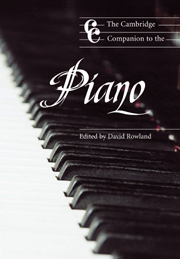Book contents
4 - The virtuoso tradition
from Part one - Pianos and pianists
Published online by Cambridge University Press: 28 September 2011
Summary
That night Sylvia took me to a friend’s house, where some Belgian musicians played chamber music … They played Mozart’s G minor piano quartet with Mark Hambourg at the keyboard. Hambourg was a pianist of the old virtuoso school; his percussive tone and his freelance treatment of the work was wholly unadaptable for Mozart.
Mark Hambourg's (1879–1960) cavalier approach to Mozart, as recalled by Artur Rubinstein (1887–1982), typifies one popular image of the Romantic virtuoso pianist: stylistically insensitive, contemptuous of textual fidelity and, to cap it all, too loud – especially in chamber music. Rubinstein heard Hambourg in 1915, but equally harsh criticisms of the ‘virtuoso school’ had been penned at least as far back as the nineteenth-century heydays of Liszt and Thalberg, whose concert triumphs served as models for many later pianists. Even today, some critics seem unable to utter the word ‘virtuosity’ without the appendages ‘empty’ or ‘meretricious’. This contrast between playing that somehow metaphysically exposes the soul of music without drawing attention to technical accomplishment, and playing in which tasteless display is paramount echoes Mozart's two-hundred-year-old criticism of Clementi as ‘a mere mechanicus’. Of course, in a fundamental sense this contrast is misleading. No player, however elevated his interpretative ability, can communicate his intentions without a sound instrumental technique (unless he becomes a conductor), and most of the great Romantic pianists were both interpreters and virtuosos of the highest order.
The golden era of Romantic pianism lasted roughly one hundred years, the famous musical duel between Liszt and Thalberg in 1837, and the death of Paderewski (the most highly paid concert pianist of all time) in 1941 being convenient, if slightly arbitrary, markers at either end.
- Type
- Chapter
- Information
- The Cambridge Companion to the Piano , pp. 57 - 74Publisher: Cambridge University PressPrint publication year: 1998
- 5
- Cited by



